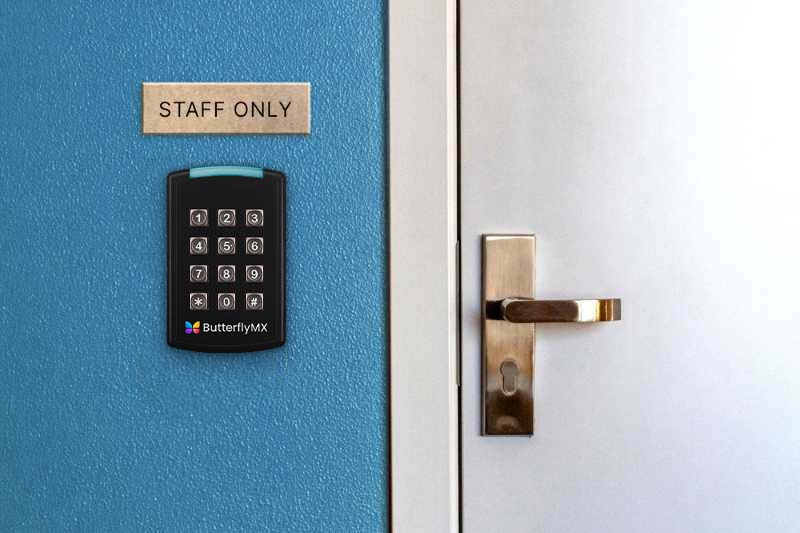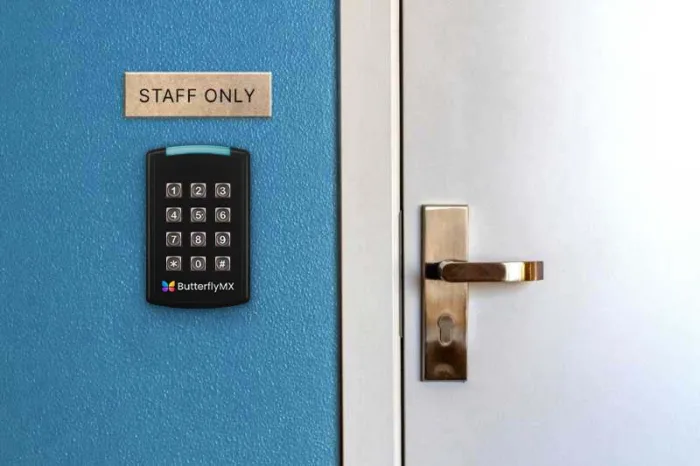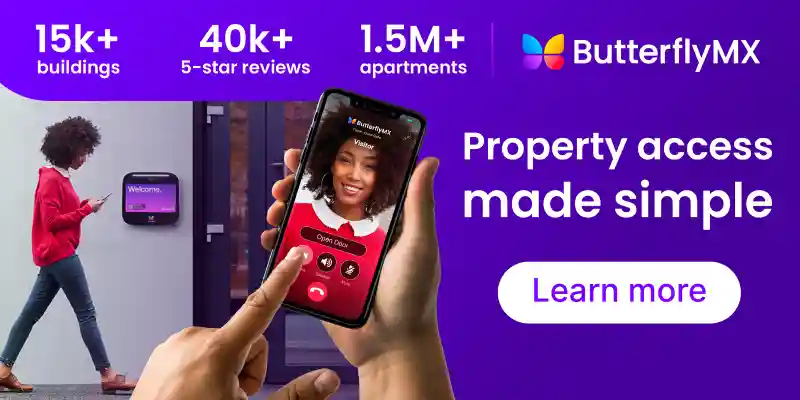Key takeaways
- A commercial access control system can manage access control at a commercial building or business.
- Office door access control solutions include key fob and key card systems, keypads, mobile access control systems, cloud-based commercial access control systems, and commercial video intercom systems.
- Your building needs commercial access control solutions to make entry easier for tenants, control access over who enters the property, and enforce existing security systems.

Traditional locks and keys have controlled access to buildings for centuries. But today, there are better solutions. Access control systems are the best way to manage access to your commercial building, office, or business. But how do you know which commercial access control system to install?
Read on to learn more about commercial access control, the types of systems available, and the best commercial access control system for you.
This guide covers:
- What is a commercial access control system?
- Finding the right commercial access system
- 5 types of commercial access control systems
- How does a commercial access control system work?
- Benefits of a commercial access control system
- Commercial access control system FAQs
What is a commercial access control system?
A commercial access control system is a type of door entry system that enables property staff to manage who can access a building or certain areas of a property.
Access control systems improve property security and convenience across offices, businesses, apartment buildings, enterprise companies, and other commercial properties. Tenants and staff who work in the building can quickly enter with a credential, but unauthorized visitors can’t get in. Some access control systems also allow visitors to request property access from tenants.
To sum up, simplify credential management by choosing between a few different access control management models.
Cost of an access control system for office and business
Commercial access control systems cost anywhere from $600 to $7,000 per door for door entry hardware.
But that’s just for the hardware. You may also have to purchase credentials — such as fobs or keycards — for each user. So, the price of your access control system may vary depending on the type of system you choose.
Additionally, you’ll have to factor in installation costs and ongoing service and maintenance fees. Access control installation could cost a few hundred or several thousand dollars. Installers set their own prices, so choose a trustworthy, certified installer who provides a clear and reasonable quote.
Finding the right commercial access system
If you’re looking to invest in a door access control system for businesses, keep an eye out for these features:
Front desk functionality
If you currently employ a receptionist or another front desk employee, you know how important they are to successful building management. Indeed, they manage appointments and help visitors and employees reach their intended destinations.
In this situation, simplify their jobs and reduce the risks of error by investing in an access control system with front desk software. Emphatically, the best access systems allow a front desk user to authenticate visitors, view live camera feeds, and speak to guests directly from their computer.
Cloud-based
Specifically, cloud-based access control has a few benefits compared to hosting your commercial access control system’s data on-site.
For one, you can count on cloud-based administration to save money. An on-site data storage system means you have to pay for servers and computers to store your data — and you’d have to manage your own cybersecurity, too.
In contrast, an access company can connect your building to the cloud to manage your data and security according to industry standards.
Delivery Passes
Commercial buildings receive high volumes of deliveries of all kinds. For example, you might have to deal with larger, company-level deliveries and individual-level food orders on the same day.
Ensure your building’s security while making the delivery process easier for couriers and residents and look for an access control system that has delivery pass functionality.
To sum up, delivery passes are electronic credentials that employees can use to text couriers. This allows couriers to easily gain access to your building with a PIN or QR code. And to ensure security, a delivery pass expires after the delivery to prevent unauthorized access.
Scalability
When choosing a commercial access control system, it’s crucial to consider whether the system can scale with your business as it grows. Enterprise-level scalability ensures that your access control solution can accommodate additional locations, more users, and increased security needs without requiring a complete overhaul.
Look for a system that supports multi-site management, where administrators can oversee access for multiple buildings from a single platform. This feature is especially valuable for businesses with multiple offices or facilities, as it simplifies the management of security across different locations.
Furthermore, it ensures that the system can integrate with other enterprise tools, such as HR software and visitor management systems, to streamline operations and improve overall efficiency.
Advanced features
Advanced security features are a must to protect sensitive data and ensure compliance with industry regulations. Seek out access control systems that offer multi-factor authentication (MFA) for an added layer of security. MFA requires users to verify their identity using two or more methods, such as a password, fingerprint, PIN code, or mobile device.
Additionally, the best enterprise access control systems also include audit trails, which log every access event. This feature helps identify and investigate security incidents and supports compliance in certain industries, which is vital for both small businesses and enterprise companies.
ButterflyMX as your commercial access control system
ButterflyMX’s commercial Access Control System provides all the features you need to manage property-wide access effectively. Not only can the access control system help manage employees or tenants, but it’s also an excellent visitor management solution.
The ButterflyMX security access control system consists of the following:
- Video Intercom. The ButterflyMX 8” or 12” Video Intercom is a modern system designed for controlling access to exterior entryways, including vestibule doors and even gates. Our Video Intercom supports immersive two-way video calls with a 156° wide-angle camera, allowing tenants to easily see who they’re speaking with. Further, the intercom is both vandal-resistant and weatherproof, meaning it will last you longer than other systems.
- Multiple ways to open the door. Our Video Intercom supports multiple credentials: the ButterflyMX mobile app, PIN codes, key cards or fobs, and Visitor Passes for delivery drivers and guests.
- Vehicle Readers. For gated properties, parking lots, and garages, the ButterflyMX vehicle gate access control system is an excellent solution for preventing long car lines at entryways. The Vehicle Reader automatically grants access to vehicles with an authorized windshield tag. That way, drivers don’t have to stop at the gate to look for a physical credential.
- ButterflyMX OS. Finally, our powerful ButterflyMX OS ties together our entire commercial Access Control solution together. From a web-based dashboard, staff members can manage permissions for the door entry system, review audit trails, adjust settings, and more. What’s more, the ButterflyMX OS is accessible remotely, so staff can manage the system whenever and wherever.
- Security Cameras. ButterflyMX Security Cameras provide the perfect vantage point to view your property from any angle. You can choose between our Bullet or Dome cameras depending on whether you want a 360-degree view or long-range monitoring.
5 types of commercial access control systems
There are many types of access control systems designed for offices and businesses.
Here are the five most common commercial building access control systems:
- Key fob and key card systems
- Keypads
- Mobile access control systems
- Cloud-based commercial access control systems
- Commercial video intercom systems
1. Key fob and key card systems
Key fob and key card entry systems are some of the most common types of commercial access control. They’re a more convenient alternative to old-school brass locks and keys.
Instead of keys, tenants use small electronic devices — either a fob or a card — to gain access. Tenants simply hold their device up to the door card reader, which scans it and checks their credentials. If the system recognizes that fob as an authorized credential, it grants building access.
Most key fob systems use RFID technology. So, that means each fob or card contains a small RFID tag that communicates wirelessly with the reader.
Although key card entry systems for businesses are more convenient than locks and keys, they still have a few drawbacks. For example, any time a tenant loses or breaks their fob, property staff must replace it. Plus, anytime an employee joins or leaves the business, staff must distribute or collect a fob and program or deactivate it accordingly.
2. Keypads
Chiefly, keypad access control consists of a device installed at the door with a numeric keypad. Each tenant and staff member receives a PIN code, which they enter at the keypad to gain access.
Keypads are convenient for office access control because they eliminate physical keys and fobs altogether. Therefore, tenants don’t have to carry around a device that they could lose or forget. Instead, they just enter their PIN code to access the building or room. Additionally, staff can easily grant or revoke tenants’ access permissions through cloud-based software.
Some keypads also pair with a mobile app, allowing tenants to open doors through their smartphones. Further, keypads with mobile apps are especially convenient because they offer more than one way to open the door.
3. Mobile access control systems
A mobile access control system is a great investment for an office or business because it allows tenants to open doors right from their mobile devices. Smartphones, tablets, and even devices like Apple Watches instantly become access credentials.
Perhaps the greatest benefit for property staff is that you no longer have to program fobs or hand out physical credentials. Specifically, since tenants use their own devices, all you have to do is manage access permissions from a cloud-based dashboard.
Another benefit to mobile access is that it removes the need for a tenant to physically touch a credential to a reader. Touchless systems like these are much more hygienic and help prevent the spread of germs, which is essential for facilities like hospitals and daycares.
4. Cloud-based commercial access control systems
A cloud-based access control system is any type of system that enables you to remotely manage and grant property access from an internet-connected device.
Traditional access control systems require you to install and maintain an on-site server. In contrast, cloud-based systems store data in the cloud. As a result, cloud-based access control systems are far easier and more affordable to maintain.
5. Commercial video intercoms systems
A commercial video intercom system is the best way to manage access at your building’s front door or gate. This multi-tenant access control system offers a seamless way for tenants to enter your building, a commercial video intercom also enables visitors to easily request property access.
There are many kinds of commercial video intercoms, but we recommend wireless systems with a mobile app. Wireless commercial intercoms are easier and more affordable to install. Additionally, a commercial intercom with a mobile app empowers tenants to open doors for themselves and visitors from their smartphones.
Other benefits of a commercial video intercom for office access control include:
- Seamless access for delivery carriers, so tenants never miss a delivery.
- Visitors can request access directly from the tenant they’re visiting — no need to go through a front desk or staff member.
- Thirdly, tenants can open the door for visitors remotely — even if they’re not in the office.
How does a commercial access control system work?
An office door access control system works by scanning an employee’s credentials and unlocking the door if it’s valid.
While there are many business access control systems, most utilize five primary components to maintain security.
The five components of a door entry system for businesses are:
- Door controller. Essentially, the door controller is the brain of your access control system. It makes all the decisions when determining if a user can be granted access or not. It can store credential information locally or be accessed via the cloud.
- Access reader. The reader is the device that accepts the user’s credentials. These are often located on a door or next to it on the wall. Many readers are known as proximity readers, meaning they only need the credential to be within a close range to accept the encrypted information.
- Access credentials. The credential is what a user gives to a reader for access. For example, physical credentials include key fobs, ID badges, key cards, or even a tenant’s fingerprint. However, credentials are not always physical. Many modern business access control systems accept a PIN code or mobile app.
- Commercial electronic door lock. Door locks engage and disengage at the direction of the controller. Overall, common types of commercial electronic door locks include electromagnetic door locks, keyless door locks, and commercial keypad door locks.
- Software. The software allows property staff to manage user permissions. With the same software, staff can gather building access intelligence and review audit logs in the event of a security breach. The best access control software is cloud-based, meaning it doesn’t require bulky, on-site equipment. Instead, the software can be accessed remotely on a desktop or even a mobile device.
Benefits of a commercial access control system
Investing in a commercial access control system means that you can ditch outdated locks and keys in favor of a cost-effective, simple keyless entry system. Commercial access control offers countless benefits for tenants, property managers, and building owners alike.
Here’s how access control for business can help you:
- Enhanced building security. A commercial access control system is a sophisticated physical security solution that lets you keep doors locked without preventing tenants from accessing them. Some systems also have a built-in camera, which can take a photo every time someone enters the building to create an audit trail.
- Simplified access for tenants. Access control enhances the tenant experience at commercial buildings by providing a seamless way for tenants to enter the building and rooms within. These methods include fingerprint access, facial recognition, and swipe-to-open options using mobile apps.
- Ditch the hassle and expense of traditional keys. The reality is that tenants lose keys all the time. And when someone loses a key, building staff must spend time and money to replace the lock and issue new keys to every tenant. Mobile credentials are a great replacement.
- Better control over who has access to specific rooms at certain times. With a commercial access control system, property managers can automate who has access to certain rooms. They can even limit access to specific times of the day.
- Integrate with other systems. Many business access control systems integrate with other smart tech solutions and software, such as Google Workspace. As a result, you can cut back on necessary work by centralizing all of your operations from a single platform.
Commercial access control system FAQ
Here are answers to your top questions about commercial access control systems:
- What is the difference between commercial access control systems and commercial smart locks?
- What’s the difference between commercial access control systems and security systems?
What is the difference between commercial access control systems and commercial smart locks?
The biggest difference between these two technologies is that office door access control systems provide a comprehensive solution for properties, while commercial smart locks are designed for a single door.
More importantly, the best enterprise access control systems integrate with smart locks to control access to sensitive areas and give your staff one platform to manage all of your property’s smart locks.
However, simply purchasing and installing smart locks within your building will not provide a property-wide access control solution. Instead, access control systems use centralized software to manage credentials and more hardware to operate effectively.
What’s the difference between commercial access control systems and security systems?
The difference between these two systems is that commercial access control systems are part of a security system that will address most security concerns.
Security systems consist of various technologies to secure a property from internal and external threats safely. To enumerate, as for access control systems, they play a role in preventing those threats from entering vulnerable areas of the property.
Other aspects of a security access system may include:
- Fencing
- Signage
- Lighting
- Security cameras
- Motion sensors
- Smoke detectors
- Carbon monoxide detectors
- Alarm systems
All in all, many technologies make up a security system, with business access control systems working alongside them.

Learn more about ButterflyMX
Fill in the form below, and we'll email you right back.
Have questions?
Fill in the form below, and we'll email you right back.






